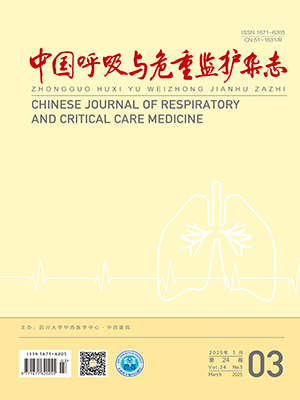Objective To explore the effects of lateral position ventilation on lung volume and oxygenation in patients with acute respiratory distress syndrome ( ARDS) . Methods Fourteen patients with ARDS were enrolled. Supine position, lateral position and supine position were successively adopted and continued for one hour respectively. End-expiratory lung volume ( EELV) was measured at the end of each epoch. Effects of different position on gas exchange, lung mechanics and hemodynamics were monitored.Results EELV was increased from ( 1109 ±321) mL to ( 1376 ±381) mL after lateral ventilation ( P lt;0. 05) , and decreased to ( 1143 ±376) mL after the second supine ventilation ( P lt;0. 05) . Compared with initial supine ventilation, there was no significant difference in EELV after the second supine ventilation
( P gt;0. 05) . PaO2 /FiO2 was increased from ( 154. 3 ±35. 0) mm Hg to ( 189. 9 ±60. 1) mm Hg after lateral ventilation ( P lt;0. 05) , and increased to ( 209. 2 ±75. 4) mm Hg after the second supine ventilation ( P lt; 0. 05) . Compared with initial supine ventilation, PaO2 /FiO2 was increased greatly after the second
supine ventilation ( P lt; 0. 01) . There was no significant difference in PaCO2 , lung mechanics and hemodynamics after changing different position. Conclusion Lateral position ventilation can increase EELV and improve oxygenation in patients with ARDS.
Citation:
YU Xiangyou,PAN Pengfei,BaihetinishaTuerdi. Effects of Lateral Position Ventilation on Lung Volume and Oxygenation in Patients with Acute Respiratory Distress Syndrome. Chinese Journal of Respiratory and Critical Care Medicine, 2009, 09(6): 555-557. doi:
Copy
Copyright © the editorial department of Chinese Journal of Respiratory and Critical Care Medicine of West China Medical Publisher. All rights reserved
| 1. |
吴威士, 罗敏, 杨翠华. 急性肺损伤/急性呼吸窘迫综合征患者侧卧位通气与俯卧位通气的对比观察. 中华结核和呼吸杂志,2004, 27: 589-592.
|
| 2. |
Tongyoo S, Vilaichone W, Ratanarat R, et al. The effect of lateral position on oxygenation in ARDS patients: a pilot study. J Med Assoc Thai, 2006, 89( Suppl 5) : S55-S61.
|
| 3. |
张丽娜, 艾宇航. 急性呼吸窘迫综合征患者侧卧位通气与俯卧位通气的临床疗效观察. 中国急救医学, 2006, 26: 908-910.
|
| 4. |
中华医学会呼吸病学分会. 急性肺损伤/急性呼吸窘迫综合征的诊断标准( 草案) . 中华结核和呼吸杂志, 2000, 23: 203.
|
| 5. |
中华医学会重症医学分会. 急性肺损伤/急性呼吸窘迫综合征诊断和治疗指南( 2006) . 中国危重病急救医学, 2006,18:706-710.
|
| 6. |
Remolina C, Khan AU, Santiago TV, et al. Positional hypoxemia in unilateral lung disease. N Engl JMed, 1981, 304: 523-525.
|
| 7. |
Flaatten H, Aardal S, Hevr y O. Improved oxygenation using the prone position in patients with ARDS. Acta Anaesthesiol Scand,1998, 42: 329-334.
|
| 8. |
Staudinger T, Kofler J, 秦龙, 等. 成人呼吸窘迫综合征病人俯卧位和持续变换体位通气的比较: 一项初步研究. 世界医学杂志,2002, 6: 9-13.
|
| 9. |
Klingstedt C, Hedenstiema G, Baehrendtz S, et al. Ventilationperfusion relationships and atelectasis formation in the supine and lateral positions during conventional mechanical and differential ventilation. Acta Anaesthesiol Scand, 1990 , 34: 421 -429.
|
| 10. |
Oleg rd C, S ndergaard S, Houltz E, et al. Estimation of functional residual capacity at the bedside using standard monitoring equipment: a modified nitrogen washout/ washin technique requiring a small change of the inspired oxygen fraction. Anesth Analg, 2005 ,101: 206-212.
|
| 11. |
Heinze H, Sedemund-Adib B, Heringlake M, et al. Functional residual capacity changes after different endotracheal suctioning methods. Anesth Analg, 2008, 107: 941-944.
|
- 1. 吴威士, 罗敏, 杨翠华. 急性肺损伤/急性呼吸窘迫综合征患者侧卧位通气与俯卧位通气的对比观察. 中华结核和呼吸杂志,2004, 27: 589-592.
- 2. Tongyoo S, Vilaichone W, Ratanarat R, et al. The effect of lateral position on oxygenation in ARDS patients: a pilot study. J Med Assoc Thai, 2006, 89( Suppl 5) : S55-S61.
- 3. 张丽娜, 艾宇航. 急性呼吸窘迫综合征患者侧卧位通气与俯卧位通气的临床疗效观察. 中国急救医学, 2006, 26: 908-910.
- 4. 中华医学会呼吸病学分会. 急性肺损伤/急性呼吸窘迫综合征的诊断标准( 草案) . 中华结核和呼吸杂志, 2000, 23: 203.
- 5. 中华医学会重症医学分会. 急性肺损伤/急性呼吸窘迫综合征诊断和治疗指南( 2006) . 中国危重病急救医学, 2006,18:706-710.
- 6. Remolina C, Khan AU, Santiago TV, et al. Positional hypoxemia in unilateral lung disease. N Engl JMed, 1981, 304: 523-525.
- 7. Flaatten H, Aardal S, Hevr y O. Improved oxygenation using the prone position in patients with ARDS. Acta Anaesthesiol Scand,1998, 42: 329-334.
- 8. Staudinger T, Kofler J, 秦龙, 等. 成人呼吸窘迫综合征病人俯卧位和持续变换体位通气的比较: 一项初步研究. 世界医学杂志,2002, 6: 9-13.
- 9. Klingstedt C, Hedenstiema G, Baehrendtz S, et al. Ventilationperfusion relationships and atelectasis formation in the supine and lateral positions during conventional mechanical and differential ventilation. Acta Anaesthesiol Scand, 1990 , 34: 421 -429.
- 10. Oleg rd C, S ndergaard S, Houltz E, et al. Estimation of functional residual capacity at the bedside using standard monitoring equipment: a modified nitrogen washout/ washin technique requiring a small change of the inspired oxygen fraction. Anesth Analg, 2005 ,101: 206-212.
- 11. Heinze H, Sedemund-Adib B, Heringlake M, et al. Functional residual capacity changes after different endotracheal suctioning methods. Anesth Analg, 2008, 107: 941-944.




